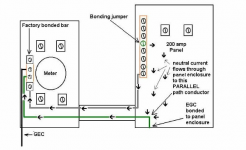Doc13067
Senior Member
- Location
- Bucks County/Philadelphia, PA USA
With regard to the GEC being bonded to the neutral at one of 3 locations, in residential I always make the bond at the first disconnect (in my case that’s almost always an indoor main breaker load center, although sometimes it’s an outside disco or ATS). If the GEC is ran to the meter socket or the service drop, for that matter, what happens afterwards, particularly at the main disconnect? I have a situation that I believe falls under 250.24(A)(3) because there are two meter sockets connected by RMC and a ground rod under them with an aluminum GEC that runs from the rod (I know, 250.64(A)) to the first meter socket and is under the same lug as the line side neutral. From there a 3-wire SEU cable goes in to the main disconnect. There is a separate GEC going from the main disconnect to a water pipe but I never understood if the “main disconnect” should be bonded or isolated when there is a GEC landed before it. I can’t seem to find the answer in the code book. Could someone help me understand this and advise on what to do with the two separate GECs? This was done in 1978.


